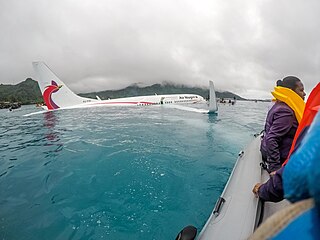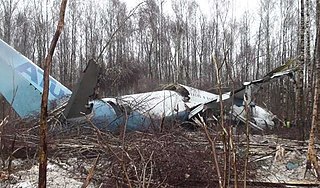
The British Aerospace 146 is a short-haul and regional airliner that was manufactured in the United Kingdom by British Aerospace, later part of BAE Systems. Production ran from 1983 until 2001. Manufacture by Avro International Aerospace of an improved version known as the Avro RJ began in 1992. A further-improved version with new engines, the Avro RJX, was announced in 1997, but only two prototypes and one production aircraft were built before production ceased in 2001. With 387 aircraft produced, the Avro RJ/BAe 146 is the most successful British civil jet airliner programme.
In aviation, a controlled flight into terrain is an accident in which an airworthy aircraft, under pilot control, is unintentionally flown into the ground, a mountain, a body of water or an obstacle. In a typical CFIT scenario, the crew is unaware of the impending disaster until it is too late. The term was coined by engineers at Boeing in the late 1970s.

A ground proximity warning system (GPWS) is a system designed to alert pilots if their aircraft is in immediate danger of flying into the ground or an obstacle. The United States Federal Aviation Administration (FAA) defines GPWS as a type of terrain awareness warning system (TAWS). More advanced systems, introduced in 1996, are known as enhanced ground proximity warning systems (EGPWS), a modern type of TAWS.
PT. Airfast Indonesia is an air carrier based in Tangerang, Indonesia in Greater Jakarta. It specialises in contract operations, aviation management services and charter passenger and cargo services to the oil, mining and construction industries in Indonesia and other countries in the area. It is also involved in aerial mapping, survey flights, heli-logging and medical evacuation services. Its main base is Soekarno-Hatta International Airport, Jakarta. Airfast Indonesia is listed in Category 1 by Indonesian Civil Aviation Authority for airline safety quality. In 2009 Airfast Indonesia was one of five airlines taken off a blacklist of airlines not allowed in European airspace due to safety concerns.

Armavia Flight 967 was a scheduled international passenger flight operated by Armavia from Zvartnots International Airport, Zvarnots in Armenia to Sochi, a Black Sea coastal resort city in Russia. On 3 May 2006, the aircraft operating the route, an Airbus A320-200, crashed into the sea while attempting a go-around following its first approach to Sochi airport; all 113 aboard were killed. The accident was the first major commercial airline crash in 2006. It was Armavia's first and only fatal crash.

Garuda Indonesia Flight 152 (GA152/GIA152) was a scheduled domestic flight operated by Garuda Indonesia from Soekarno-Hatta International Airport, Tangerang to Polonia International Airport, Medan in Indonesia. On 26 September 1997, the aircraft flying the route crashed into mountainous woodlands near the village of Buah Nabar, Sibolangit, killing all 222 passengers and 12 crew members on board. It is the deadliest aviation disaster in Indonesia's history.
Manunggal Air Services was an airline based in Jakarta, Indonesia. It operated charter passenger and cargo services within Indonesia and neighbouring regions. Its main base was Halim Perdanakusuma Airport, Jakarta.

In aviation, a terrain awareness and warning system (TAWS) is generally an on-board system aimed at preventing unintentional impacts with the ground, termed "controlled flight into terrain" accidents, or CFIT. The specific systems currently in use are the ground proximity warning system (GPWS) and the enhanced ground proximity warning system (EGPWS). The U.S. Federal Aviation Administration (FAA) introduced the generic term TAWS to encompass all terrain-avoidance systems that meet the relevant FAA standards, which include GPWS, EGPWS and any future system that might replace them.
Trigana Air is an airline based in Jakarta, Indonesia.

PauknAir Flight 4101 was a British Aerospace 146 that crashed on a flight from Málaga, Spain, to the Spanish North African exclave of Melilla on 25 September 1998. All 38 passengers and crew on board the aircraft were killed in the accident.

Merpati Nusantara Airlines Flight 9760D was a domestic commercial passenger 50-minutes flight, flying from Sentani Airport in Papua's Province Jayapura to Oksibil Airport in Oksibil, Indonesia operated by a de Havilland Canada DHC-6 Twin Otter 300. On Sunday, August 2, 2009, while carrying fifteen people over Papua, the aircraft went missing en route. Its wreckage was found a few miles from Oksibil two days later. All 12 passengers and 3 crew members were killed in the accident.
PT Aviastar Mandiri, operating as Aviastar is an Indonesian growing domestic passenger airline based in East Jakarta, Jakarta, Indonesia.

Wamena Airport is an airport serving the town of Wamena, Jayawijaya Regency, Highland Papua, Indonesia. The airport also serves the neighboring Lanny Jaya Regency and Tolikara Regency. It is currently the only airport in the highland region of Papua that can accommodate narrow-body aircraft such as the Airbus A320, Boeing 737 and C-130 Hercules.

On 9 May 2012, a Sukhoi Superjet 100 airliner on a demonstration tour in Indonesia crashed into Mount Salak, in the province of West Java. All 37 passengers and 8 crew on board were killed. The plane had taken off minutes before from Jakarta's Halim Airport on a promotional flight for the recently launched jet, and was carrying Sukhoi personnel and representatives of various local airlines.

Trigana Air Flight 267 was a scheduled passenger flight from Sentani to Oksibil in the eastern Indonesian province of Papua. On 16 August 2015, the ATR 42 turboprop operating the service crashed on approach in the Bintang highlands region of Oksibil, killing all 49 passengers and 5 crew members.

Aviastar Flight 7503 was a regional flight from Masamba to Makassar, Indonesia. On 2 October 2015, the de Havilland Canada DHC-6 Twin Otter aircraft serving the route went missing with 10 on board near Palopo minutes after takeoff. There was no distress call from the plane.

Air Niugini Flight 73 was a scheduled service from Pohnpei, Federated States of Micronesia (FSM) to Port Moresby, Papua New Guinea, via Chuuk, FSM. On 28 September 2018, a Boeing 737, operated by Air Niugini, landed short of the runway at Chuuk International Airport in Weno (FSM) and came to rest in Chuuk Lagoon. Locals in small boats rescued most passengers and all crew members. One passenger was initially declared missing. He was later found dead by rescue divers. Forty-six people survived but six of them were injured.
Dimonim Air is a national airline in Indonesia, with services that are "chartered airlines." It has an air base at Sentani International Airport, and its head office is on Jl. Cidurian No.6 Cikini, Central Jakarta.













